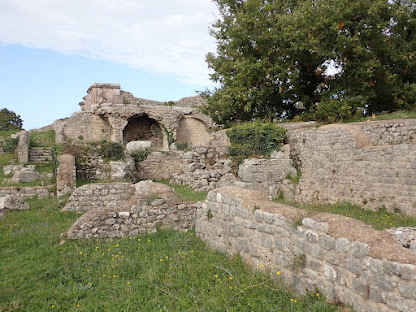18 October 2024


First, a quick history: Many Middle Bronze Age (roughly 1700-1350 BCE) communities had developed prior to the Romans in Umbria, the central portion of Italy between the two coasts and not far from Rome. Carsulae (pronounced 

So the city flourished for many years. While being easily accessible for trade and travel being right on a major roadway, the city was also easily accessible to robbers, marauders, 

Carsulae was eventually abandoned and left to the elements. Excavations of the ancient city began some time in the 16th century, with a more intensive and scientific uncovering of the ruins in the 1950s to 1970s, CE. Archaeological digs continue to this day. And
only a fraction of the 
The central area that has been excavated includes the entrance arches, one still standing (or possibly restored); the forum flanked by two temples; a series of large and small rooms possibly used for government officials; and 
A road running perpendicular to the Flaminia leads to arts and entertainment buildings: an amphitheatre, constructed in an old sinkhole; a full theatre (more like a small colosseum, which differs 

There's also what 
SO many amazing things to see at this archaeological park! From the entrance, there are paved paths over the gentle hills, leading to the various unearthed buildings. But sometimes, a better overview was 
The Romans weren't the most imaginative society, but they certainly could plan, build, and engineer 
While I knew the Romans built roads, I never somehow understood that these were actually somewhat paved roads, with rounded stones lined up to make an actual surface for horses, chariots, and whatever kind of wagon-like conveyance they might have used! With flat fieldstone sort of rocks lining the sides of this ancient highway! History makes so much more
sense when you can actually SEE what was done, and why these roads were considered marvelous inventions at the time they were built! (Given those flat stones along the sides, making the road almost like a trench, I suspect gravel or dirt was used to fill in the road and make a smoother riding surface. The stones would help with drainage and prevent the dirt from becoming too muddy. No idea if this is true, but it kind of makes sense.)
And stairs! Yes, of course, the ancient Greeks used stepped platforms for their temples. But the Romans used stairs so people could easily walk up the slight rise from the Via Flaminia to the forum! Who knew?
I think my favorite, though, was the amphitheatre. The wood stage floor is obviously new, the wood seats are as well. (A few stone seats were still visible.) And if you look below the stage, there are various walls, likely rooms and corridors. I know ancient Greek amphitheatres had places to the "gods" and "goddesses" and other magical beings could suddenly appear on stage. So I'm guessing that's another creative thing the Romans borrowed from the Greeks, and built into their amphitheatres.
There were also walls where rectangular and square shaped rocks where used to make patters - look closely, the squares are turned so they're diamond shaped! However did some mason keep the rocks turned on point as they built the wall???
It was an amazing morning!!! SO glad I finally made it to Carsulae! I had a few extra minutes before our bus was due, and there's a lovely gift and coffee shop (with bathroom facilities) by the entrance/exit - our day was definitely autumnal, so that morning cappuccino was very warming!




Carsulae has an interesting history. Thanks for sharing. Beautiful photos, as always. History DOES make more sense when you can see it!
ReplyDeleteHugs
Barb
Thanks for sharing.